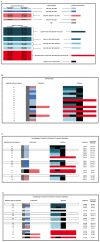Allele-level haplotype frequencies and pairwise linkage disequilibrium for 14 KIR loci in 506 European-American individuals
- PMID: 23139747
- PMCID: PMC3489906
- DOI: 10.1371/journal.pone.0047491
Allele-level haplotype frequencies and pairwise linkage disequilibrium for 14 KIR loci in 506 European-American individuals
Abstract
The immune responses of natural killer cells are regulated, in part, by killer cell immunoglobulin-like receptors (KIR). The 16 closely-related genes in the KIR gene system have been diversified by gene duplication and unequal crossing over, thereby generating haplotypes with variation in gene copy number. Allelic variation also contributes to diversity within the complex. In this study, we estimated allele-level haplotype frequencies and pairwise linkage disequilibrium statistics for 14 KIR loci. The typing utilized multiple methodologies by four laboratories to provide at least 2x coverage for each allele. The computational methods generated maximum-likelihood estimates of allele-level haplotypes. Our results indicate the most extensive allele diversity was observed for the KIR framework genes and for the genes localized to the telomeric region of the KIR A haplotype. Particular alleles of the stimulatory loci appear to be nearly fixed on specific, common haplotypes while many of the less frequent alleles of the inhibitory loci appeared on multiple haplotypes, some with common haplotype structures. Haplotype structures cA01 and/or tA01 predominate in this cohort, as has been observed in most populations worldwide. Linkage disequilibrium is high within the centromeric and telomeric haplotype regions but not between them and is particularly strong between centromeric gene pairs KIR2DL5∼KIR2DS3S5 and KIR2DS3S5∼KIR2DL1, and telomeric KIR3DL1∼KIR2DS4. Although 93% of the individuals have unique pairs of full-length allelic haplotypes, large genomic blocks sharing specific sets of alleles are seen in the most frequent haplotypes. These high-resolution, high-quality haplotypes extend our basic knowledge of the KIR gene system and may be used to support clinical studies beyond single gene analysis.
Conflict of interest statement
Figures






Similar articles
-
Conserved KIR allele-level haplotypes are altered by microvariation in individuals with European ancestry.Genes Immun. 2012 Jan;13(1):47-58. doi: 10.1038/gene.2011.52. Epub 2011 Jul 28. Genes Immun. 2012. PMID: 21796155 Free PMC article.
-
KIR haplotypes defined by segregation analysis in 59 Centre d'Etude Polymorphisme Humain (CEPH) families.Immunogenetics. 2008 Dec;60(12):767-74. doi: 10.1007/s00251-008-0334-y. Epub 2008 Oct 30. Immunogenetics. 2008. PMID: 18972110 Free PMC article.
-
Killer Ig-like receptor haplotype analysis by gene content: evidence for genomic diversity with a minimum of six basic framework haplotypes, each with multiple subsets.J Immunol. 2002 Nov 1;169(9):5118-29. doi: 10.4049/jimmunol.169.9.5118. J Immunol. 2002. PMID: 12391228
-
The killer cell immunoglobulin-like receptor (KIR) genomic region: gene-order, haplotypes and allelic polymorphism.Immunol Rev. 2002 Dec;190:40-52. doi: 10.1034/j.1600-065x.2002.19004.x. Immunol Rev. 2002. PMID: 12493005 Review.
-
Role of Centromeric and Telomeric Haplotypes of Killer-Cell Immunoglobulin-Like Receptors (KIRs) in Disease Susceptibility: A Research Review.Cureus. 2025 May 8;17(5):e83728. doi: 10.7759/cureus.83728. eCollection 2025 May. Cureus. 2025. PMID: 40486331 Free PMC article. Review.
Cited by
-
Coherent somatic mutation in autoimmune disease.PLoS One. 2014 Jul 2;9(7):e101093. doi: 10.1371/journal.pone.0101093. eCollection 2014. PLoS One. 2014. PMID: 24988487 Free PMC article. Review.
-
The combinatorial diversity of KIR and HLA class I allotypes in Peninsular Malaysia.Immunology. 2021 Apr;162(4):389-404. doi: 10.1111/imm.13289. Epub 2020 Dec 20. Immunology. 2021. PMID: 33283280 Free PMC article.
-
High-resolution KIR and HLA genotyping in three Chinese ethnic minorities reveals distinct origins.HLA. 2024 Apr;103(4):e15482. doi: 10.1111/tan.15482. HLA. 2024. PMID: 38625090 Free PMC article.
-
Human NK cell receptor KIR2DS4 detects a conserved bacterial epitope presented by HLA-C.Proc Natl Acad Sci U S A. 2019 Jun 25;116(26):12964-12973. doi: 10.1073/pnas.1903781116. Epub 2019 May 28. Proc Natl Acad Sci U S A. 2019. PMID: 31138701 Free PMC article.
-
Unveiling the Significance of HLA and KIR Diversity in Underrepresented Populations.Biomedicines. 2024 Jun 15;12(6):1333. doi: 10.3390/biomedicines12061333. Biomedicines. 2024. PMID: 38927540 Free PMC article. Review.
References
-
- Martin AM, Freitas EM, Witt CS, Christiansen FT (2000) The genomic organization and evolution of the natural killer immunoglobulin-like receptor (KIR) gene cluster. Immunogenetics 51: 268–280. - PubMed
-
- Martin AM, Kulski JK, Gaudieri S, Witt CS, Freitas EM, et al. (2004) Comparative genomic analysis, diversity and evolution of two KIR haplotypes A and B. Gene. 335: 121–131. - PubMed
-
- Lanier LL (2005) NK cell recognition. Annu Rev Immunol 23: 225–274. - PubMed
-
- Uhrberg M, Valiante NM, Shum BP, Shilling HG, Lienert-Weidenbach K, et al. (1997) Human diversity in killer cell inhibitory receptor genes. Immunity 7: 753–763. - PubMed
Publication types
MeSH terms
Substances
LinkOut - more resources
Full Text Sources
Other Literature Sources

